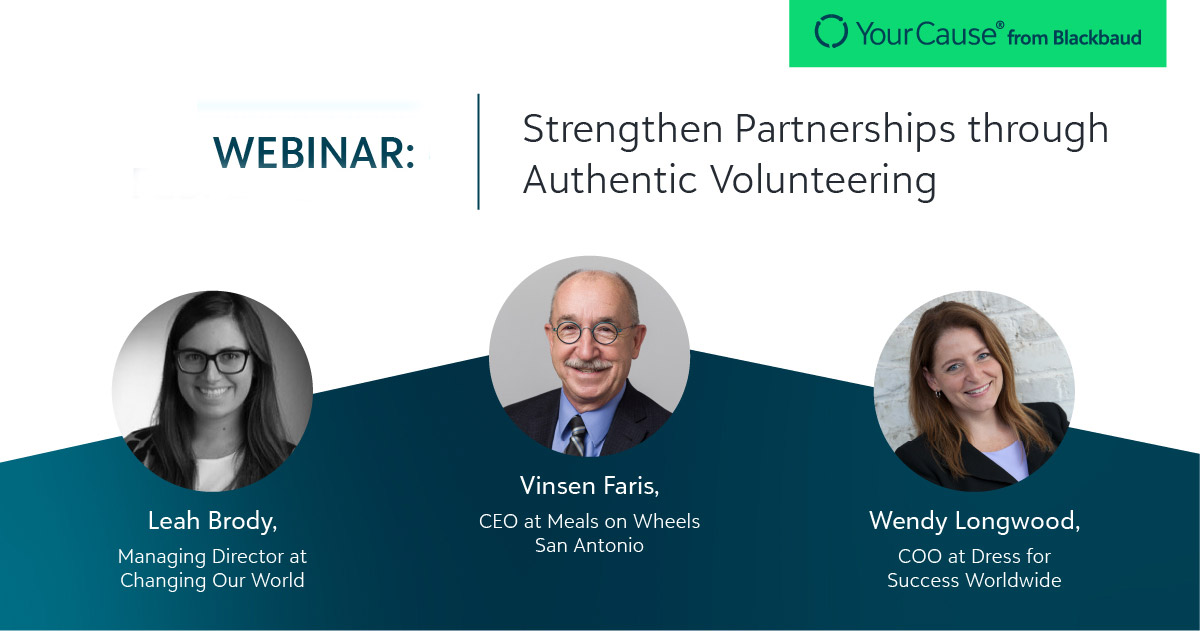Understanding the Shift in Community Needs
Authors: Sarah Kitslaar & Emily Sommer
In March of 2020, the COVID-19 pandemic changed the world as we knew it, especially in the volunteering and nonprofit space. Many nonprofits are still feeling the weight of the challenges they faced during the height of the pandemic, including long-term financial stability, operation costs, and funding. We partnered with social impact advisory firm Changing Our World to host a conversation with Dress for Success Worldwide and Meals on Wheels to discuss the changing landscape of corporate volunteerism and how to forge successful public/private partnerships.
This panel was moderated by Leah Brody, Managing Director at Changing Our World, and featured Vinsen Faris, CEO at Meal on Wheels, San Antonio and Wendy Longwood, COO at Dress for Success Worldwide. Each of these leaders shared their experience cultivating successful corporate/nonprofit partnerships and some tips for how to work together to create strategic and authentic employee engagement programs. In Case You Missed It: You can watch the event on-demand.
“During the onset of the pandemic, only 5-10% of our affiliates offered virtual programming, though as the pandemic progressed this number quickly rose to 90%, allowing Dress for Success to continue our work in a remote environment.”
-Wendy Longwood
Historically, Dress for Success’ services were almost exclusively brick and mortar, with an operating model focused on in-person career prep. At the start of the pandemic, they had to rapidly adjust their programming virtually to continue to serve the needs of their clients. Like many other organizations, they’ve ultimately shifted to a hybrid model, but the changes they made at the start of the pandemic have permanently altered their approach and disrupted their volunteer needs. Previously, Dress for Success had easy plug and play opportunities for corporate groups, like helping sort and organize their clothing donations. But their need for this inventory, and thus the inventory itself, has rapidly declined, paving the way for smaller and more nuanced volunteer activities.
The pandemic similarly affected Meals on Wheels San Antonio, whose operations relied heavily on in-person meal delivery. At the start of the pandemic, they quickly went from 50 meal pick-up locations a day down to just 1, and from daily meal deliveries to twice weekly. And, at the same time, the demand for their services skyrocketed. It has taken time and effort to get back to daily meal deliveries – the regular volunteers they relied on pre-pandemic have not returned in the same numbers, and their corporate engagement has dwindled. While Meals on Wheels San Antonio is still working to build up their volunteer teams to be where they were prior to 2020, it’s been challenging to rebuild their volunteer corps.
How to Strengthen Nonprofit Partnerships through Authentic Volunteering
So, how can companies help navigate this new normal, engaging their employees while making sure they’re meeting the needs of their community partners? Wendy with Dress for Success and Vinsen with Meals on Wheels highlight the ways companies can address the challenges described. Leah summed up their key considerations for any company to create successful partnerships.
1. Be Flexible
The nonprofit’s needs may not align to your specific timeline; be open to opportunities that require a shift from your master plan.
While your volunteer month might align to April’s National Volunteer Month, it might not align to the needs of your nonprofit partner. Don’t write off an opportunity too fast just because it doesn’t fall within a desired timeframe.
2. Stay Local
Volunteer needs vary from city to city, even neighborhood to neighborhood. A local approach to volunteering (vs. a national one) can better address a community’s unique needs.
We know corporate giving teams are small, and it can be overwhelming working to coordinate volunteer projects at a local level, but, it’s hard for nonprofits to understand (and address) the needs of individual communities from a regional or national perspective. Try to connect with a local contact to ensure volunteers are addressing the most pressing needs in their specific location.
3. Fill a Gap
You don’t always need to recreate the wheel! Tap into existing volunteer activities when available.
As a corporate partner, it is important to think about how your team can assist with tasks and volunteer efforts that already exist. Filling in the gaps for pre-existing volunteer opportunities aid nonprofits by helping them address an immediate pain-point, rather than diving into an area that doesn’t currently need any assistance.
4. Encourage Open Communication
Even a one-time volunteer opportunity is a partnership; both parties need to be open about their needs and capacities.
It is important for both parties to align from the get-go; neither should feel like they’re sacrificing to ‘make it work’. If your volunteer activity must fall on your company’s day of service, tell the nonprofit upfront. And if your nonprofit organization specifically needs volunteers on a different day, you don’t need to create something just to partner. As Wendy so beautifully put it “not every nonprofit needs every corporation, and vice versa.”
5. Consider Strategic Partnerships
Find the right relationships and invest in them. Nonprofit partners that are aligned to your company’s mission can yield strong, impactful partnerships that can grow together for years to come.
Where there are strong points of alignment between both parties is where the most productive and beneficial relationship is born. Strategic partnerships take time, and funding, but can exponentially achieve outcomes and make substantial impacts, while allowing for customized and collaborative engagement opportunities.
We’ve all gotten familiar with the phrase “change is constant” and as the world of work moves toward an increased focus on flexibility in a hybrid environment, the ways of employee engagement will need to adapt. If we continue to be open, honest, and flexible, we’ll be able to navigate these changes, and create meaningful opportunities for employees and companies to make an impact together with nonprofits.

